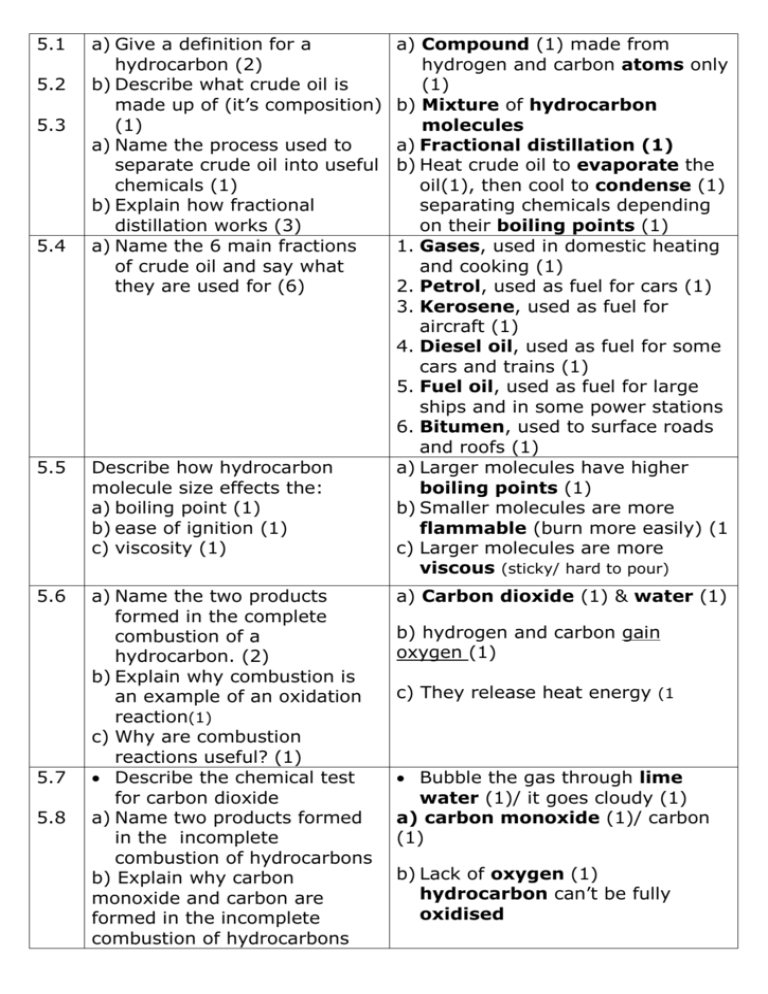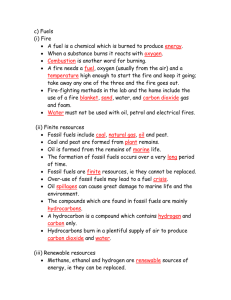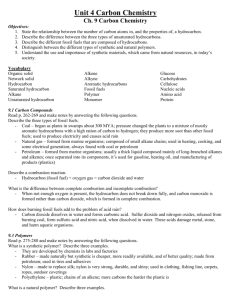5783-C1.5 Fuels QQT Cards - 333.05 KB
advertisement

5.1 5.2 5.3 5.4 a) Give a definition for a hydrocarbon (2) b) Describe what crude oil is made up of (it’s composition) (1) a) Name the process used to separate crude oil into useful chemicals (1) b) Explain how fractional distillation works (3) a) Name the 6 main fractions of crude oil and say what they are used for (6) 5.5 Describe how hydrocarbon molecule size effects the: a) boiling point (1) b) ease of ignition (1) c) viscosity (1) 5.6 a) Name the two products formed in the complete combustion of a hydrocarbon. (2) b) Explain why combustion is an example of an oxidation reaction(1) c) Why are combustion reactions useful? (1) Describe the chemical test for carbon dioxide a) Name two products formed in the incomplete combustion of hydrocarbons b) Explain why carbon monoxide and carbon are formed in the incomplete combustion of hydrocarbons 5.7 5.8 a) Compound (1) made from hydrogen and carbon atoms only (1) b) Mixture of hydrocarbon molecules a) Fractional distillation (1) b) Heat crude oil to evaporate the oil(1), then cool to condense (1) separating chemicals depending on their boiling points (1) 1. Gases, used in domestic heating and cooking (1) 2. Petrol, used as fuel for cars (1) 3. Kerosene, used as fuel for aircraft (1) 4. Diesel oil, used as fuel for some cars and trains (1) 5. Fuel oil, used as fuel for large ships and in some power stations 6. Bitumen, used to surface roads and roofs (1) a) Larger molecules have higher boiling points (1) b) Smaller molecules are more flammable (burn more easily) (1 c) Larger molecules are more viscous (sticky/ hard to pour) a) Carbon dioxide (1) & water (1) b) hydrogen and carbon gain oxygen (1) c) They release heat energy (1 Bubble the gas through lime water (1)/ it goes cloudy (1) a) carbon monoxide (1)/ carbon (1) b) Lack of oxygen (1) hydrocarbon can’t be fully oxidised 5.9 5.10 5.11 5.12 5.13 5.14 Name a problem caused by carbon monoxide gas (1) I can describe two problems caused by incomplete combustion of hydrocarbons in appliances (2) a) I can name the impurity in hydrocarbon fuels that causes acid rain (1) b) I can name the main gas that causes acid rain (1) Bonus write a word equation I can describe some of the effects of acid rain (1) a) Name 3 gases that cause global warming (3) b) I can explain how theses gases cause global warming c) I can describe how human activities cause gases in the Earths atmosphere to vary 5.15 Name two methods scientists are using to try and reduce the level carbon dioxide in the atmosphere today 5.16 Use the graph below to help evaluate how far the correlation between global temperature and the proportion of carbon dioxide in the atmosphere provides evidence for climate change Toxic/ takes place of oxygen in your blood/ can kill you (1) Carbon monoxide is a poison (1)/ Carbon or soot makes buildings dirty and causes global dimming (1) a) Sulfur (1) b) Sulfur dioxide (1) sulphur + → sulphur dioxide oxygen Destroys trees, kills fish and corrodes buildings a) Carbon dioxide/ Methane/ water vapour (3) b) Green house gases trap suns energy in the atmosphere/ keeping Earth warmer Burning fossil fuels / cutting down trees Iron seeding of oceans (1)/ converting carbon dioxide into hydrocarbons (1) (Iron increases photosynthesis in plants in the oceans, taking in carbon dioxide) Carbon dioxide levels have increased in the last 100 years, so has the average temperature on Earth. There is a correlation between increased carbon dioxide levels and increased temperature 5.17 Name some possible alternatives to fossil fuels 5.18 a) Describe how the ethanol is made b) Explain why alternative biofuels are important 5.19 Evaluate the advantages and disadvantages of replacing fossil fuels with biofuels. (4) ethanol/ biodiesel / hydrogen (1) a) From fermentation of sugar beet. (1) b) Reduces demand for petrol 5.20 Explain the properties that make a good fuel (4) a) How flammable- The more easily it burns the better. (1) b) Amount of smoke produced- less smoke is better (1) c) Heat energy released- more heat make a better (1) d) How easy it is to transport- the easier the better. Liquids are better for cars (1) 5.21 a) Write the word equation to show the reaction that takes place in a hydrogen fuel cell. b) Bonus mark write the balanced symbol equation a) Hydrogen + → water Oxygen 5.22 a) I can identify advantages of using the hydrogen fuel cell in cars instead of petrol. b) I can identify disadvantages of using the hydrogen fuel cell in cars instead of petrol. a) Only waste product is water/ Can be made from renewable water using electrolysis b) Difficult to store gases as they take more space/ can be made from non-renewable oil this releases carbon dioxide a) Advantages: Biofuels are renewable (1)/ plants take in carbon dioxide when grown, this is released when fuel burned (1) (carbon neutral). Disadvantages: Growing crops takes up land(1) so less land for growing food, food prices could increase (1) b) 2H2 + O2 → 2H2O (1) (1) 5.23 a) Name 3 non-renewable fossil a) petrol (1) kerosene (1) and diesel fuels found in crude oil (3) oil (1) b) Name a non-renewable fossil b) Methane (1) fuel found in natural gas (1) 5.24 a) Identify variables to control when carrying out a test to compare the heat released by burning different fuels b) Interpret the results below showing temperature from this experiment to identify the best fuel. Explain how you know (2) Fuel Temperature rise °C A 22 B 34 C D a) Same volume of water to be heated/ same mass of fuel/ fuel is same distance from the water/ water is heated in the same size tube or beaker b) Fuel D is the best fuel (1) Biggest temperature increase(1) 12 55 5.25 I can described why alkanes Molecules made from hydrogen are described as saturated and carbon atoms that only hydrocarbons contain single bonds between 5.27 I can described why alkenes atoms are described as unsaturated Molecules made from hydrogen hydrocarbons and carbon atoms that contain a 5.29 I can describe a test to tell if double bond between two carbon a chemical is an alkane or an atoms (the bonds between atoms alkene in hydrocarbon molecules are covalent bonds) Add brown bromine water/ alkenes decolourise the water. (In alkanes the bromine water stays brown) 5.26 Draw diagrams to represent the a) b) alkanes: a) Methane CH4 b) Ethane C2H6 c) Propane C3H8 d) Recall the general formula c) d) CnH2n+2 for an alkane 5.28 Draw diagrams to represent the a) alkenes: a) Ethene C2H4 b) Propene C3H6 c) Recall the general formula for an alkene CnH2n b) 5.30 What happens to hydrocarbons during cracking? (2) 5.31 Explain why cracking is necessary, refer to demand for different hydrocarbons and their uses(4) 5.32 Describe how to crack liquid paraffin in the laboratory. Draw a diagram if it helps (2) 5.33 a) What is a monomer? (1) Large hydrocarbons are broken into smaller alkanes (1) and alkenes (1) Large hydrocarbon alkanes are poor fuels (1)/ and are in less demand (1)/ Smaller hydrocarbon alaknes are in high demand (1)/ as they are better fuels (1)/ Alkenes are used to make plastics (1) Liquid paraffin is heated so it evaporates (1) & breaks into smaller molecules that are gases. Gases are collected under water. (1) a) An alkene/ unsaturated hydrocarbon b) What is a polymer? (1) b) A long chain molecule made from a repeating structure c) What happens in a c) The double bond in the polymerisation reaction? (3) monomer opens up (1) and many monomer molecules join d) Name the polymer formed together (1)to from a large from the monomer ethene (1 polymer molecule (1 d) Poly(ethene) 5.35 a) I can recall a use for a) Plastic bags/ plastics bottles/ poly(ethene) and name cling film/ insulation for electrical properties that make it wires (1) suitable for the job Flexible/cheap / good insulator b) I can recall a use for (1) poly(chloroethene) or PVC b) Window frames/ pipes/ insulation and name properties that for electrical wires (1) make it suitable for the job Tough/ cheap/ good insulator (1) c) I can recall a use for PTFE c) Non stick coatings/ Containers for and name properties that corrosive chemicals (1) make it suitable for the job Tough/ slippery/ resistant to corrosion (1) 5.36 a) I can define the term a) Material breaks down overtime biodegradable (1) (1) b) I can recall three ways of b) Burry in land fill (1) burn (1) disposing of plastics (2) recycle (1) 5.34 a) Name the polymer formed from propene (1) and draw the repeat unit after seeing the starting molecule (1) b) Name the polymer formed from chloroethene (1) and draw the repeat unit after seeing the starting molecule (1) c) Name the polymer formed from tetrafluoroethene (1) after seeing the starting molecule (1) 5.37 a) Identify and evaluate the advantages and disadvantages of recycling plastic b) Identify and evaluate the advantages and disadvantages of burning plastic c) Identify and evaluate the advantages and disadvantages of making biodegradable plastic a) Poly(propene) Starting molecule Repeat unit b) Poly(chloroethene) Starting molecule Repeat unit c) Poly(tetrafluoroethene) or PTFE Starting molecule Repeat unit a) Advantages: Less waste goes to land fill/ Conserves raw materials/ less energy is used/ Less carbon dioxide gas given off Disadvantages: Expensive to sort out plastics from other waste b) Advantages: Less waste goes to land fill/ Releases heat energy (1)/ used to generate electricity (1) Disadvantage: Could release harmful gases c) Advantage: Breaks down into harmless chemicals in the ground/ reduces waste going to landfill Disadvantages: More expensive to make







